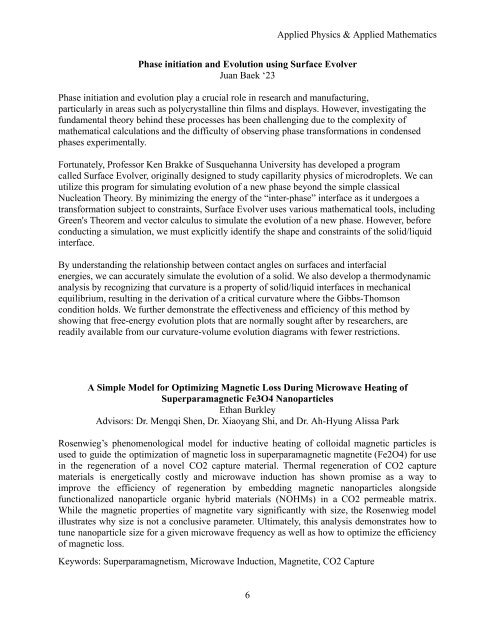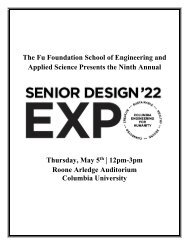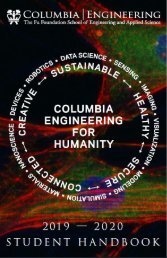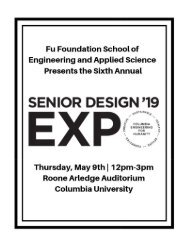Create successful ePaper yourself
Turn your PDF publications into a flip-book with our unique Google optimized e-Paper software.
Applied Physics & Applied Mathematics<br />
Phase initiation and Evolution using Surface Evolver<br />
Juan Baek ‘23<br />
Phase initiation and evolution play a crucial role in research and manufacturing,<br />
particularly in areas such as polycrystalline thin films and displays. However, investigating the<br />
fundamental theory behind these processes has been challenging due to the complexity of<br />
mathematical calculations and the difficulty of observing phase transformations in condensed<br />
phases experimentally.<br />
Fortunately, Professor Ken Brakke of Susquehanna University has developed a program<br />
called Surface Evolver, originally designed to study capillarity physics of microdroplets. We can<br />
utilize this program for simulating evolution of a new phase beyond the simple classical<br />
Nucleation Theory. By minimizing the energy of the “inter-phase” interface as it undergoes a<br />
transformation subject to constraints, Surface Evolver uses various mathematical tools, including<br />
Green's Theorem and vector calculus to simulate the evolution of a new phase. However, before<br />
conducting a simulation, we must explicitly identify the shape and constraints of the solid/liquid<br />
interface.<br />
By understanding the relationship between contact angles on surfaces and interfacial<br />
energies, we can accurately simulate the evolution of a solid. We also develop a thermodynamic<br />
analysis by recognizing that curvature is a property of solid/liquid interfaces in mechanical<br />
equilibrium, resulting in the derivation of a critical curvature where the Gibbs-Thomson<br />
condition holds. We further demonstrate the effectiveness and efficiency of this method by<br />
showing that free-energy evolution plots that are normally sought after by researchers, are<br />
readily available from our curvature-volume evolution diagrams with fewer restrictions.<br />
A Simple Model for Optimizing Magnetic Loss During Microwave Heating of<br />
Superparamagnetic Fe3O4 Nanoparticles<br />
Ethan Burkley<br />
Advisors: Dr. Mengqi Shen, Dr. Xiaoyang Shi, and Dr. Ah-Hyung Alissa Park<br />
Rosenwieg’s phenomenological model for inductive heating of colloidal magnetic particles is<br />
used to guide the optimization of magnetic loss in superparamagnetic magnetite (Fe2O4) for use<br />
in the regeneration of a novel CO2 capture material. Thermal regeneration of CO2 capture<br />
materials is energetically costly and microwave induction has shown promise as a way to<br />
improve the efficiency of regeneration by embedding magnetic nanoparticles alongside<br />
functionalized nanoparticle organic hybrid materials (NOHMs) in a CO2 permeable matrix.<br />
While the magnetic properties of magnetite vary significantly with size, the Rosenwieg model<br />
illustrates why size is not a conclusive parameter. Ultimately, this analysis demonstrates how to<br />
tune nanoparticle size for a given microwave frequency as well as how to optimize the efficiency<br />
of magnetic loss.<br />
Keywords: Superparamagnetism, Microwave Induction, Magnetite, CO2 Capture<br />
6








